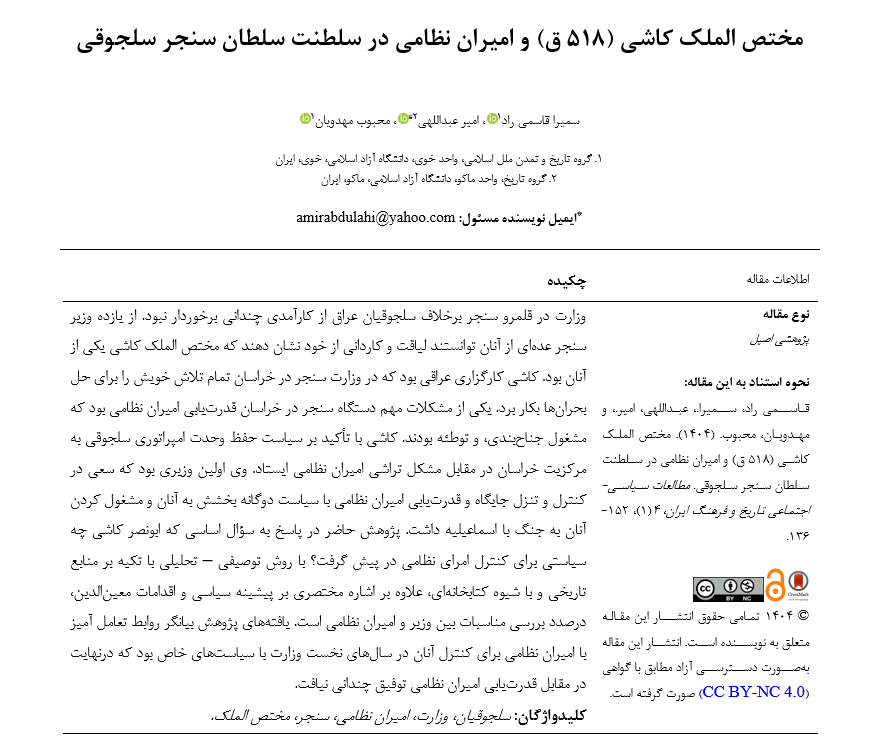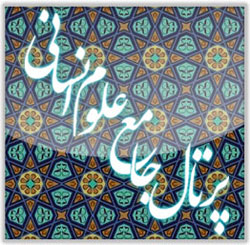مختص الملک کاشی (518 ق) و امیران نظامی در سلطنت سلطان سنجر سلجوقی
کلمات کلیدی:
سلجوقیان, وزارت, امیران نظامی, سنجر, مختص الملکچکیده
وزارت در قلمرو سنجر برخلاف سلجوقیان عراق از کارآمدی چندانی برخوردار نبود. از یازده وزیر سنجر عدهای از آنان توانستند لیاقت و کاردانی از خود نشان دهند که مختص الملک کاشی یکی از آنان بود. کاشی کارگزاری عراقی بود که در وزارت سنجر در خراسان تمام تلاش خویش را برای حل بحرانها بکار برد. یکی از مشکلات مهم دستگاه سنجر در خراسان قدرتیابی امیران نظامی بود که مشغول جناحبندی، و توطئه بودند. کاشی با تأکید بر سیاست حفظ وحدت امپراتوری سلجوقی به مرکزیت خراسان در مقابل مشکل تراشی امیران نظامی ایستاد. وی اولین وزیری بود که سعی در کنترل و تنزل جایگاه و قدرتیابی امیران نظامی با سیاست دوگانه بخشش به آنان و مشغول کردن آنان به جنگ با اسماعیلیه داشت. پژوهش حاضر در پاسخ به سؤال اساسی که ابونصر کاشی چه سیاستی برای کنترل امرای نظامی در پیش گرفت؟ با روش توصیفی – تحلیلی با تکیه بر منابع تاریخی و با شیوه کتابخانهای، علاوه بر اشاره مختصری بر پیشینه سیاسی و اقدامات معینالدین، درصدد بررسی مناسبات بین وزیر و امیران نظامی است. یافتههای پژوهش بیانگر روابط تعامل آمیز با امیران نظامی برای کنترل آنان در سالهای نخست وزارت با سیاستهای خاص بود که درنهایت در مقابل قدرتیابی امیران نظامی توفیق چندانی نیافت.
دانلودها
مراجع
Aghili, S. D. (1985). Akhbar al-Wuzara. Tehran: Information.
Bandari. (1977). Zubdat al-Nasr wa Nukhbat al-Asr. Tehran: Foundation of Culture.
Bayhaqi, I. F. History of Bayhaqi. Tehran: Foroughi Bookstore.
Bosworth, C. E. (2001). The Seljuks. Tehran: Tehran Publishing.
Boyle, J. A. (2001). Cambridge history of Iran. Tehran: Amir Kabir.
Ghazali, I. M. (1954). Fada'il al-Anam min Rasail Hujjat al-Islam. Tehran: Sanaei and Tahouri.
Halimi, A. K. (2004). The Seljuk state. Tehran: Research Institute of Hawzah and University.
Hassan-Zadeh, I. (2006). A different approach to the political behavior of Abu al-Qasim Dargazini. Historical Essays, 19(4).
Hassan-Zadeh, I. (2007). Reforms and political instability during the Seljuk period. Research Journal of the Faculty of Literature and Humanities, Isfahan University, 2(50).
Hassan Zadeh, I., & Abdollahi, M. (2014). Reforms of Kamal al-Din Khazan. Journal of the History and Civilization of Islamic Nations(19).
Hosseini, A. (2025). News of the Seljuk state. Beirut.
Ibn Athir, I. (1972). The complete history of Islam and Iran. Tehran: Scientific Publishing.
Ibn Hawqal. (1987). Surat al-Ard. Tehran: Amir Kabir.
Ibn Khaldun, A. (1985). Al-Ibar. Tehran: Cultural Studies and Research.
Iqbal, A. (2009). The ministry during the reign of the Great Seljuk Sultans. Tehran: University Press.
Katib Isfahani, I. D. (2006). History of the Saljuqid dynasty. Beirut.
Khatibi, A. Abu Nasr Kashi In: Encyclopedia of Islam (Vol. 6). Tehran: Center for the Great Islamic Encyclopedia.
Khwandamir, G. (1956). Dastur al-Wuzara. Tehran: Iqbal.
Klozner, K. (2002). Bureaucracy in the Seljuk era. Tehran: Amir Kabir.
Lampton, A. K. S. (1984). A journey through the history of Iran after Islam. Tehran: Amir Kabir.
Lampton, A. K. S. (1993). Continuity and change in the medieval history of Iran. Tehran: Ney Publishing.
Manzooralajdad, S. M. H. (2004). The political power of the Imamites during the Seljuk dynasty. Journal of Islamic History(18).
Monshi Kermani, N. (1983). Samat al-Ali lil-Hadra al-Ulya. Tehran: Asatir.
Monshi Kermani, N. (1985). Nasaim al-Asrar. Tehran: Information.
Mostowfi, H. (1985). Taarikh-e Gozideh. Tehran: Amir Kabir.
Motahari, H. R. (2015). Imamite Shiite agents in the Seljuk government apparatus. Journal of Historical Speech, 9(21).
Neyshaburi, Z. D. (1953). Seljuknameh. Tehran: Kallaleh Khavar.
Nizam al-Mulk Tusi, Q. D. (1961). Siyasatnama. Tehran: Habibi Book Company.
Qazvini, R. (1979). Ba'da al-Mathalib al-Nawasib fi Naqz Ba'da Fada'il al-Rafidah. Tehran.
Qomi, H. b. A. History of Qom. Tus Publishing.
Qomi, N. D. (1985). History of the ministers. Tehran: Institute for Cultural Studies and Research.
Rashid al-Din Fazlullah, H. (1983). Jami' al-Tawarikh. Tehran: Donyaye Ketab.
Rawandi, M. b. A. (1984). Rahat al-Sudur wa Ayat al-Surur. Tehran: Scientific Publishing.
Sadeghi, M. A. (1998). The position of the ministry during the reign of Sanjar. Journal of the Faculty of Literature and Humanities, Tabriz, 66.
Sanders, K. (2010). Bureaucracy in the Seljuk era. Tehran: Amir Kabir.
Satarzadeh, M. (2013). The Seljuks. Tehran: Samt Publishing.
Tahmasbi, S. (2003). Competition between the Iraqis and Khorasanis in Seljuk bureaucracy. Letter of the Association(3 & 4).
Tatuvi, Q. A. K. Tarikh al-Fai. Tehran: Scientific and Cultural Publishing.
Yaqut al-Hamawi, S. A. (1960). Mu'jam al-Buldan. Beirut: Dar al-Ihya al-Turath al-Arabi.
Youssefi Far, S. (2008). The political, social, economic, and cultural transformations of Iran during the Seljuk period. Tehran: Payame Noor University.








